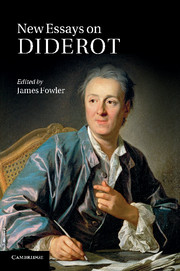Book contents
- Frontmatter
- Contents
- Notes on contributors
- Acknowledgements
- List of abbreviations
- Introduction
- PART I DIDEROT THE PHILOSOPHE
- 1 Diderot and the ancients
- 2 Diderot's earlier philosophical writings
- 3 The Encyclopédie: innovation and legacy
- 4 Diderot, Rousseau and the art of craft
- 5 Diderot's anti-colonialism: a problematic notion
- 6 Diderot's letters to Sophie Volland
- PART II NOVELS
- PART III DIALOGUES
- PART IV PLAYS AND DRAMATIC THEORY
- PART V MUSIC, PERFORMANCE, AESTHETICS
- Select bibliography
- Index
- References
2 - Diderot's earlier philosophical writings
Published online by Cambridge University Press: 11 April 2011
- Frontmatter
- Contents
- Notes on contributors
- Acknowledgements
- List of abbreviations
- Introduction
- PART I DIDEROT THE PHILOSOPHE
- 1 Diderot and the ancients
- 2 Diderot's earlier philosophical writings
- 3 The Encyclopédie: innovation and legacy
- 4 Diderot, Rousseau and the art of craft
- 5 Diderot's anti-colonialism: a problematic notion
- 6 Diderot's letters to Sophie Volland
- PART II NOVELS
- PART III DIALOGUES
- PART IV PLAYS AND DRAMATIC THEORY
- PART V MUSIC, PERFORMANCE, AESTHETICS
- Select bibliography
- Index
- References
Summary
Diderot's standing as a philosopher is decidedly non-standard. It is odd in a number of ways. First, he worked for much of his life as a part of various socio-professional groups – different ones succeeding each other from the 1740s on: the Encyclopédistes during the later 1740s and the 1750s when he acted as the director of the great Encyclopédie; painters, architects and doctors in the 1760s, their information, and sometimes their personalities, brought into the trilogy Le Rêve de d'Alembert (D'Alembert's Dream) and into his art criticism, the great Salons of the 60s; the team round Raynal putting together the history of colonialism and European expansion, Histoire des deux Indes (A History of the Two Indies) during the 1760s and 1770s; the very wealthy Baron d'Holbach's coterie from about 1752 on, and the materialist–atheist volumes it produced.
- Type
- Chapter
- Information
- New Essays on Diderot , pp. 31 - 46Publisher: Cambridge University PressPrint publication year: 2011
References
- 2
- Cited by

